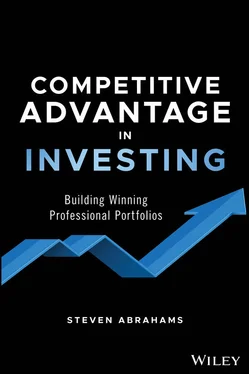Limit of Liability/Disclaimer of Warranty
While the publisher and authors have used their best efforts in preparing this work, they make no representations or warranties with respect to the accuracy or completeness of the contents of this work and specifically disclaim all warranties, including without limitation any implied warranties of merchantability or fitness for a particular purpose. No warranty may be created or extended by sales representatives, written sales materials or promotional statements for this work. The fact that an organization, website, or product is referred to in this work as a citation and/or potential source of further information does not mean that the publisher and authors endorse the information or services the organization, website, or product may provide or recommendations it may make. This work is sold with the understanding that the publisher is not engaged in rendering professional services. The advice and strategies contained herein may not be suitable for your situation. You should consult with a specialist where appropriate. Further, readers should be aware that websites listed in this work may have changed or disappeared between when this work was written and when it is read. Neither the publisher nor authors shall be liable for any loss of profit or any other commercial damages, including but not limited to special, incidental, consequential, or other damages.
Library of Congress Cataloging-in-Publication Data
Names: Abrahams, Steven, 1959- author.
Title: Competitive advantage in investing : building winning professional portfolios / Steven Abrahams.
Description: First Edition. | Hoboken : Wiley, 2020. | Includes index.
Identifiers: LCCN 2019056753 (print) | LCCN 2019056754 (ebook) | ISBN 9781119619840 (cloth) | ISBN 9781119619857 (adobe pdf) | ISBN 9781119619864 (epub)
Subjects: LCSH: Investments. | Portfolio management.
Classification: LCC HG4521 .A216 2020 (print) | LCC HG4521 (ebook) | DDC 332.6—dc23
LC record available at https://lccn.loc.gov/2019056753
LC ebook record available at https://lccn.loc.gov/2019056754
Cover Design: Wiley
Cover Image: © ChubarovY/Getty Images
To Maryann and Stuart ,
who got me started ,
and to Valerie, Ben, Margot, and Jake ,
who kept me going .
Take a little time at some point to look over the public portfolios of a few larger investors. Pick a mix of mutual funds or hedge funds or banks or insurers, for example. It could include almost any professionally managed portfolio. It should start to become clear that investing takes place over a wide and diverse landscape.
Each portfolio will differ from others in ways large and small. Each manager will describe the business in different terms. Some will talk about stocks, some about bonds, some about things different altogether. Some will emphasize income, some will emphasize price. Some will talk stability, others not. Issues important to one will barely show up in the notes for another. Each portfolio will seem to run like a separate business. And that is true for the thousands of portfolios that come into the markets every day.
Similar to any other business, investment portfolios compete to make the best out of opportunities that flow through the markets daily. Similar to any other business, the most successful assess themselves and others up and down the line and create and sustain competitive advantage. Plenty of good work has challenged the ability of any investor to consistently beat the competition. But practitioners and students of finance increasingly realize some portfolios simply are better positioned than others to generate quality returns. The reasons vary, but the best investors know their relative strengths and weaknesses and try to anticipate circumstances where their strengths might capture returns unavailable to others in the market. The competitive landscape constantly evolves. Investing is a competition, but not everyone is playing the same game.
Most of the written work on investing barely reflects the diversity of portfolios and the competition between them. The daily press and most magazines, journals, and books usually offer an eclectic mix. There's the daily drama of winners and losers. There's nuts-and-bolts advice for practitioners. There are formal treatments of finance that abstract away from the institutional details of the markets. Between these islands of information is a sparse archipelago. This book tries to build a bridge from daily headlines to the actual work of most institutional portfolio managers and on to the formal literature on investing.
The formal literature does capture an important strand of institutional investing in its emphasis on balancing risk and return. This strand tends to view investing as a world of assets with particular expected risks, returns, and correlations. In the version of this world that has dominated formal finance since the 1950s, all investors see the future in just the same way and share the same expectations of asset performance. In its strongest form, the formal work in finance largely rules out the possibility of portfolios with sustainable strengths and weaknesses. This line of work has produced important insight into the best ways to trade off return against risk in both individual investments and portfolios. It has put an important spotlight on the value of diversification. And it has led to valuable tools for breaking investor performance into the part likely due to simply taking risk and the part due to the managers' skill. At some point, practicing institutional investors do balance the relative value of different assets and try to add something to portfolio performance.
Still, some of the most widely taught tenets of modern investing seem oddly distant from the concerns and activity of investors in the market every day. Some theories imply investors should largely hold portfolios of similar assets, but few do. Some theories imply little room for investors to generate performance much better than the broad market, but investors nevertheless go into the market looking for it every day. Some theories imply that investment risk, return, and correlation is all that matters, but the daily work of professional investors seems consumed by so many other things.
The formal literature on investing often assumes away the institutional constraints that set boundaries for portfolios managing most of the world's capital. These constraints create the strengths and weaknesses that enable different portfolios to look at the same assets and see different opportunities. Only in the last decade or so have some of the best students of finance at universities and investment portfolios started to weave these constraints into explanations of asset returns and market behavior. Work that explains the origin of institutional constraints and their impact on investment and asset value offers a better theory of the markets. It explains more of investors' observed behavior.
Although the formal literature rarely deals with the institutional constraints, the literature for practitioners at times seems to deal only with these constraints. Part of the practitioners' literature lays out the definitions and conventions of securities markets. Part focuses on accounting, tax, and regulation. Part focuses on ways to finance investments. Part outlines ways to manage assets against liabilities. These are necessary and practical topics, but they do not point the way toward building a competitive investment business. Among other things, the work for practitioners rarely links back to the genuinely valuable framework that ties risk to reward and highlights the powerful implications of diversification.
Competitive advantage shapes the business of investing as much as it does any business. Some portfolios find themselves better equipped to expand into new areas or respond to investment opportunity. Some find themselves better able to leverage, deleverage, or tailor the risk and return in existing assets. Some portfolios find themselves better informed, better able to hold assets under different accounting or tax treatments, better able to navigate regulations and politics. These things and others create configurations of competitive advantage.
Читать дальше












